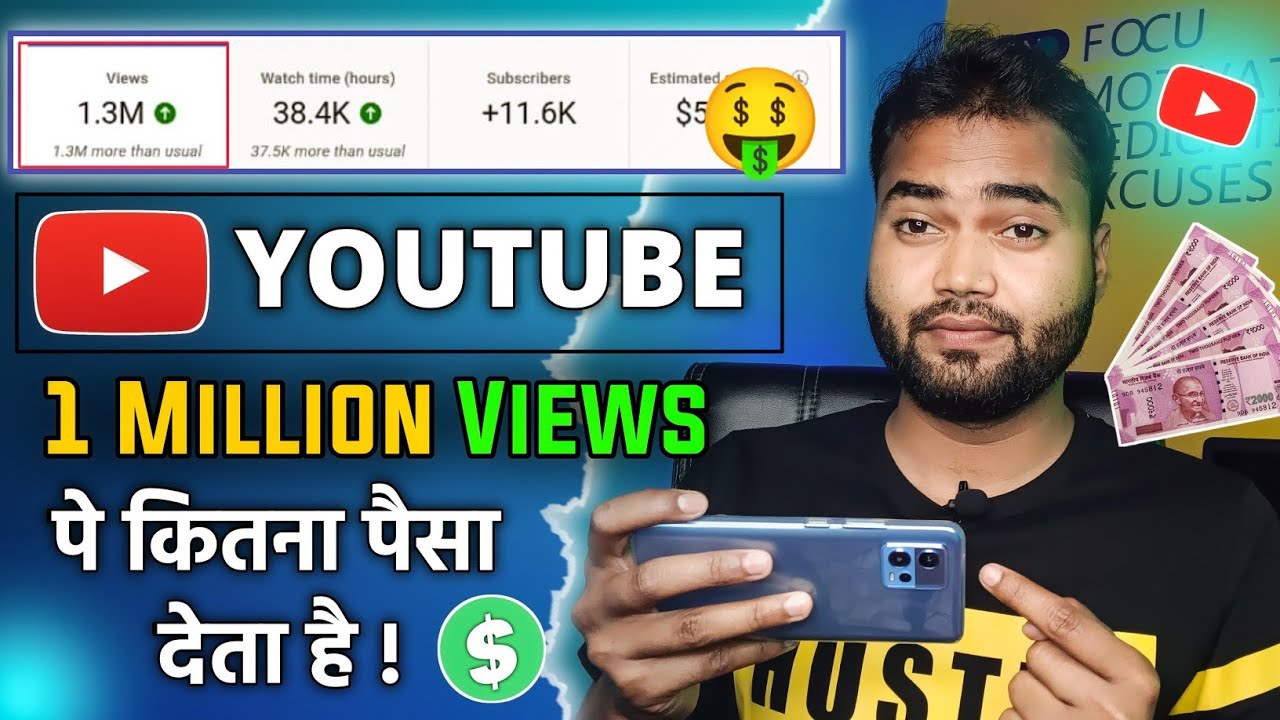YouTube monetization in Pakistan has gained significant attention as more creators join the platform eager to share their passions while earning a little extra income. So how does it all work? Simply put, YouTube lets creators earn money by displaying ads on their videos. But there’s a lot more to the story than just ads!
First, to monetize your content on YouTube, you need to join the YouTube Partner Program (YPP). To qualify, you must have:
- At least 1,000 subscribers
- 4,000 watch hours in the past 12 months
- Follow YouTube's policies and guidelines
- A linked AdSense account
Once you meet these criteria, you can start earning money from ads, channel memberships, super chats, and more! But how do views translate into income? Well, that's influenced by various factors, including who is watching, what ads are shown, and the niche your content covers.
In Pakistan, ad rates can differ from global standards, typically categorized under CPM or Cost Per Mille, which is the rate advertisers pay per 1,000 views. Pakistani CPM rates tend to be lower than in more developed markets, often ranging between $0.50 to $3.00 for a thousand views. However, this can fluctuate based on the content's nature and audience demographics.
Despite these variations, many creators have found success on the platform. It's not just about going viral or having millions of views; it's about building a community that’s engaged and supportive. So if you’re considering diving into YouTube, remember that consistency and authenticity are key to keeping your audience coming back for more!
Factors Influencing YouTube Earnings

So, you're curious about what actually determines how much YouTube pays for 1 million views in Pakistan? It’s essential to realize that several factors influence earnings. Let's break them down:
1. Audience Location: One of the biggest influencers is the geographical location of your audience. Advertisers pay more for viewers in countries with higher purchasing power, like the U.S. or Canada, compared to Pakistan. Hence, having a significant international viewership can increase your earnings potential.
2. Content Niche: Different niches come with different CPM rates. For example, finance and technology videos generally attract higher CPMs than entertainment or lifestyle content. If your channel focuses on trending or sought-after niches, you're likely to see better earnings.
3. Type of Ads Displayed: The format of the ads shown in your videos also impacts your earnings. Skippable ads, non-skippable ads, bumper ads, and overlay ads all offer varying compensation rates. Non-skippable ads usually pay more but can be less favorable to viewers.
4. Seasonality and Market Trends: Ad rates can fluctuate throughout the year due to seasonality. For example, during holidays, businesses tend to ramp up their advertising budgets, leading to higher CPM rates. Keeping an eye on market trends can enhance your earnings during peak times.
5. Viewer Engagement: Engagement metrics, such as likes, comments, and shares, can influence how often your videos are promoted by YouTube's algorithm. More engagement means more views, which can lead to increased ad revenue.
In summary, while it might be tempting to chase that 1 million views mark, remember that YouTube earnings are a complex mix of many factors. Focusing on creating quality content that resonates with your audience will often lead to better engagement and higher earnings in the long run. So keep at it, and those views might just turn into a nice paycheck!
Also Read This: How to Disable Restricted Mode on YouTube for iPhone Users
3. Breaking Down the Payment Structure

When it comes to understanding how much YouTube pays for 1 million views, it’s essential to unravel the payment structure that the platform uses. Unlike a flat fee, YouTube employs a system heavily influenced by several factors, including ad types, viewer demographics, channel niche, and engagement rates.
Here’s a simplified breakdown of how the payment structure works:
- Ad Revenue: YouTube creators earn most of their income through advertisements shown on their videos. YouTube operates on a cost-per-thousand impressions (CPM) model, which means that creators earn a set amount for every 1,000 times an ad is viewed.
- Types of Ads: Different ads yield different earnings. There are skippable ads, non-skippable ads, and display ads, each with their CPM rates. Non-skippable ads tend to generate higher revenue but may annoy viewers.
- Viewer Demographics: The geographical location of your audience plays a crucial role. Advertisers pay more to target audiences in countries where they can expect higher returns on their investments. In Pakistan, the CPM might be lower than in Western countries due to varying market demands.
- Channel Niche: Certain niches attract higher-paying ads. For example, technology, finance, and lifestyle channels often command better CPM rates compared to entertainment or vlogging channels.
- Engagement Metrics: Channels with high viewer engagement—comments, likes, shares—often attract more lucrative advertising deals. If viewers are actively interacting with your content, advertisers take notice.
In essence, while it might seem like a straightforward calculation, the reality is that multiple factors determine the amount YouTube pays you for your views. Therefore, growing your channel’s revenue involves focusing on content that engages your audience and attracts quality advertisers.
Also Read This: What Should Be My First YouTube Video
4. Average Earnings for 1 Million Views in Pakistan
Now, let’s talk numbers. So, how much does YouTube pay for 1 million views in Pakistan? The answer varies widely based on the factors we discussed earlier, but we can provide some estimates to give you a clearer idea.
On average, YouTubers in Pakistan can expect a CPM ranging from $0.50 to $5.00. This translates to an average earning scenario like this:
| CPM Rate | Earnings for 1 Million Views |
|---|---|
| $0.50 | $500 |
| $1.00 | $1,000 |
| $2.00 | $2,000 |
| $3.00 | $3,000 |
| $5.00 | $5,000 |
From these figures, it’s clear that the potential earnings can vary significantly. If an average Pakistani YouTuber earns around $1.00 CPM for their videos, they may take home around $1,000 for 1 million views.
However, it's important to note that this is just the initial estimate. Factors like monetization methods beyond ads—sponsorships, merchandise sales, and affiliate marketing—can significantly boost these earnings.
The bottom line is, while earning money on YouTube is possible for creators in Pakistan, the journey requires dedication, strategy, and a good understanding of the platform’s intricacies.
Also Read This: How to Do Giveaways on YouTube: A Complete Guide to Running Successful Giveaways
5. Comparing YouTube Payments with Other Platforms
When it comes to monetizing content online, YouTube is one of the giants, but it’s not the only player in the game. If you’re curious about how YouTube payments stack up against other platforms like Twitch, TikTok, or Facebook, you’ve come to the right place!
First off, let’s talk about YouTube's Ad Revenue Model. YouTube primarily pays creators through ad revenue, which means the amount you earn can vary widely based on factors such as the number of views, the demographics of your audience, and the type of ads displayed. In general, YouTube tends to pay around $1 to $3 per 1,000 views, translating to between $1,000 to $3,000 for 1 million views. This range can shift based on the content niche and the season.
Now, let’s take a look at how that compares to other platforms:
- Twitch: If you’re streaming video games, Twitch provides a different model. While you can earn revenue through ads, subscriptions, and donations, many streamers report making around $250 to $2,000 per million views, depending on their engagement levels and subscriber count.
- TikTok: TikTok has a Creator Fund that pays creators based on view counts, but the rates are typically lower. Reports suggest around $20 to $40 per million views, which is significantly less than YouTube.
- Facebook: On Facebook Watch, monetization is done through ad revenue as well, but again, the payout can be unpredictable due to factors like audience engagement and content type. On average, you might expect payouts similar to or slightly less than YouTube.
As you can see, YouTube generally offers more robust earning potential per million views compared to these other platforms. However, many creators diversify their income streams across multiple platforms. This strategy not only increases potential earnings but also allows creators to reach different audiences. Who wouldn’t want to grab a piece of every pie?
Also Read This: How to Get YouTube Back on My Phone After Uninstallation
6. Tips for Increasing YouTube Revenue
So, you’ve decided to dive into YouTube to enhance your content creation and make some extra cash along the way. Great choice! Here are some practical tips to boost your YouTube revenue:
- Focus on Niche Content: Creators who target specific niches often find a more engaged audience, which can lead to better monetization opportunities. Think about what unique angle or topic you can provide that’s missing in the market.
- Engage with Your Audience: Building a community is vital. Respond to comments, ask for feedback, and encourage participation in your videos. The more your audience feels connected, the more likely they are to watch regularly and share.
- Optimize for SEO: Use keywords effectively in your titles, descriptions, and tags. Proper SEO techniques can make your videos more discoverable in search results, potentially bringing in more views. Use tools like Google Trends or TubeBuddy to find trending topics!
- Expand into Affiliate Marketing: If you’re reviewing products or creating tutorials, consider partnering with brands for affiliate marketing. This can provide another revenue stream that complements your existing YouTube earnings.
- Make Use of Merchandise: If you have a substantial following, selling branded merchandise can kill two birds with one stone—promote your brand while bringing in additional revenue.
- Collaborate: Partnering with other YouTubers can help you tap into new audiences. Collaboration might seem daunting, but it's a fantastic way to gain exposure and increase your subscriber count.
By applying these strategies, you’ll not only increase your views but also create a more sustainable income on YouTube. Remember, building revenue takes time, effort, and creativity. Enjoy the process, and most importantly, keep creating amazing content!
Conclusion: Maximizing Your Earnings on YouTube in Pakistan
Maximizing your earnings on YouTube in Pakistan requires a strategic approach that combines quality content creation with effective monetization techniques. Here are some essential tips to enhance your revenue potential:
- Focus on Niche Content: Identify a specific niche that resonates with your target audience. Popular categories in Pakistan include entertainment, education, and technology.
- Optimize Your Videos for SEO: Use relevant keywords, engaging titles, and detailed descriptions to improve visibility on YouTube search results.
- Engage with Your Audience: Build a community by responding to comments and encouraging viewers to subscribe and share your videos. A loyal audience can significantly boost your earnings.
- Diversify Revenue Streams: Besides ad revenue, consider other monetization methods such as affiliate marketing, sponsored content, and merchandise sales.
- Consistency is Key: Maintain a regular upload schedule to keep your audience engaged. This can also help improve your channel's overall performance on the platform.
Lastly, keep an eye on analytics to understand what content performs best and adjust your strategy accordingly. By implementing these strategies, you can effectively maximize your earnings on YouTube in Pakistan and pave the way for long-term success.
 admin
admin








